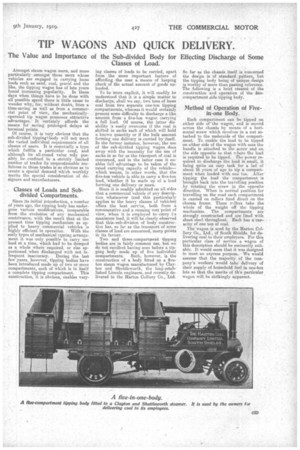TIP WAGONS AND QUICK DELIVERY.
Page 9

If you've noticed an error in this article please click here to report it so we can fix it.
The Value and Importance of the Sub-divided Body for Effecting Discharge of Some Classes of Load.
Amongst steam wagon users, and more particularly amongst those users whose vehicles are engaged in carrying loose loads such as sand, coal, gravel and the like, the tipping wagon has of late years found increasing popularity. In these days when things have to be done with all possible speed there is little cause to wonder why, for, without doubt, from a time-saving as well as from a commercial point of view, the mechanicallyoperated tip wagon possesses attractive advantages. • It certainly affords the means for saving prolonged delays at terminal points.
Of course, it is very obvious that the sub-divided tippinglbody will not? meet the varied individual requirements of all classes of users. It is essentially a type which fulfills a particular need, and although its all-round value my possibly . be confined to a strictly limited number of trades its unquestionable usefulness in those trades is so obvious as to create a special demand which worthily merits the special consideration of designers and manufacturers.
. Classes of Loads and Subdivided Compartments.
Since its initial introduction, a number of years ago, the tipping body has undergone various modifications, inseparable from the evolution of any mechanical contrivance, with the result that at the present time tipping mechanism as applied to heavy commercial vehicles is highly efficient in operation. With the early types of mechanical tipping arrangement it was only possible to carry one load at a time, which had to be dumped as a whole where required, or else apportioned when discharged with not infrequent inaccuracy. During the last few years, however, tipping bodies have been introduced made up of two or more compartments, each of which is in itself a complete tipping compartment. This construction, it is obvious, enables vary
ing classes of loads to be carried, apart from the more important feature of affording the user a means of keeping check of the actual amount of goods unloaded.
To be more explicit, it will readily be understood that it is a simple matter to discharge, shall we say, two tons of loose coal from two separate one-ton tipping compartments, whereas it would certainly present some difficulty to discharge a like, amount from a five-ton wagon carrying a full load. Of course, the latter disability is easily overcome if the coal is shifted in sacks each of which will hold a known quantity or if the bulk amount forming one delivery is carried by itself. In the former instance, however, the use of the sub-divided tipping wagon does away with the necessity for the use of sacks in so far as the transport of coal is concerned, and in the latter case it enables full advantage to be taken of the rated carrying capacity of the vehicle— which means, in other words, that the five-ton vehicle is able to carry a five-ton load, whether it be made up of a load forming one delivery or more. Since it is readily admitted on all fides that a commercial vehicle of any description whatsoever (and this particularly applies to the heavy classes of vehicles) offers the best zenece, both from a remunerative and a running cost point of view, when it is employed to,carry is maximum load, it wilt be clearly observed that this sub-division of body construction has, so far as the. transport of some classes of load are concerned, many points in its favour.
Two and three-compartment -tipping bodies are in fairly common use, but we do not recollect baying seen before a tipping body made up of five individual compartments. Such, however, is the construction of a body fitted on a fiveton steam wagon manufactured. by Clayton and Shuttleworth, the long-estahliahed Lincoln engineers. arid recently delivered to the Horton Colliery Co., Ltd. So far as the chassis itself is concerned the design is of standard pattern, but the tipping body being of unique design is worthy of more than passing reference. The following is a brief résumé of the construction and operation of the fivecompartment side tipping body.
Method of Operation of Fivein-one Body.
Each compartment can be tipped on either side of' the wagon, and is moved across the chassis by means of a horizontal screw which revolves in a nut attached to the underside of the compartment. To enable the load to be tipped on either side of the wagon with ease the handle is attached to the screw end on the side opposite to that. where the load is required to be tipped. The power required to discharge the load is small, it being quite an easy task for a lad of about 16 years of age to tip a compartment when loaded with one ton. After tipping the load • the compartment is brought back into the travelling position by rotating the screw in the opposite direction. When in normal position for travelling on the road each compartment is carried on rollers flied direct on the chassis frame. These milers take the whole of the weight off the tipping mechanism. The compartments are strongly constructed and are lined with sheet steel throughout,. Each has a Capacity of one ton of coal.
The"wagon is used by the 'Tartan CollieryCo., Ltd., of South Shields. for delivering coal to their employees. For this particular class of service a wagon of this description should be eminently suitable. It would seem that it was designed to meet an express purpose. We would assume that the majority of the company's workers would take delivery of their supply of household fuel in one-ton lots so that the merits of this particular wagon will be strikingly apparent.






















